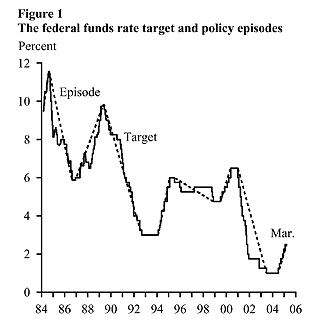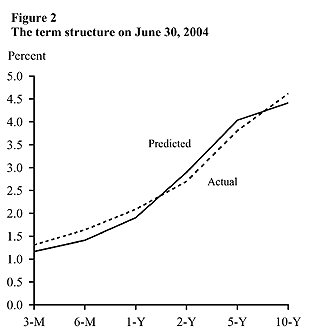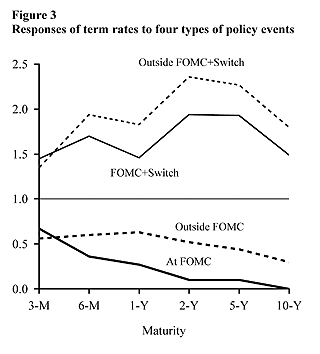There is a well-worn story that illustrates how economists view financial markets (and, perhaps, the rest of the world). An economist and a non-economist are walking down the street. The non-economist spots a $20 bill on the sidewalk and starts to reach for it.
- Monetary policy gradualism and the 3.75% rule of thumb
- Changes in the fed funds rate: when are they informative and when are they “old news”?
- Conclusion
- References
There is a well-worn story that illustrates how economists view financial markets (and, perhaps, the rest of the world). An economist and a non-economist are walking down the street. The non-economist spots a $20 bill on the sidewalk and starts to reach for it. “Don’t bother,” says the economist. “If it were real, somebody would have picked it up already.”
A version of this story explains, in part, what moves long-term interest rates. Long-term nominal interest rates should be an average of current and expected nominal short-term rates. For example, the return on a six-month Treasury bill (T-bill) should be comparable to the return on a three-month T-bill that gets rolled over for an additional three months. If the returns on these two six-month investments with similar risk differed significantly, there would be an arbitrage opportunity consisting of selling short one investment and buying long into the other for a positive profit at zero net cost. And, to an economist, that’s just as unlikely a possibility as that someone had walked past a $20 bill lying on the sidewalk.
This “no arbitrage” argument plays a critical role in the way monetary policy decisions affect the economy. The Federal Reserve makes decisions about a very short-term rate—the federal funds rate, which is an overnight rate. And because, in theory, there are no arbitrage opportunities, the market’s expectations about future changes in the federal funds rate will influence market rates of much longer maturities today and eventually aggregate spending (especially investment)—the ultimate goal for controlling inflation.
The problem is that researchers who examine the relationship between short-term rates and long-term rates find little empirical evidence to support the “no arbitrage” argument. As a result, it would seem that the Federal Reserve does not have any influence on long-term rates.
This Economic Letter argues that the Fed exercises significant influence on long-term rates. The key to reconciling this position with the empirical evidence resides in the gradual pattern of policy interventions characteristic of the Federal Open Market Committee (FOMC). This pattern, a likely reflection of the Fed’s response to changes in economic activity in the long run (see Rudebusch 2002), is essential to understanding fluctuations in long-term rates.
Monetary policy gradualism and the 3.75% rule of thumb


Figure 1 displays the federal funds rate target from March 1984 to March 2005 and shows that the Fed usually undertakes a change in the policy stance in a measured and gradual way: the Fed moves in small incremental steps in the same direction over a long period of time. In fact, a crude average over this period suggests that once a new policy direction is taken, the Fed will increase (or lower) this target by 3.75% over the span of two years at a rate of 0.165% per month (approximately 25 basis points per FOMC meeting over 15 consecutive meetings).
Suppose we take the 3.75% rule of thumb and apply it to the latest round of Fed increases, which began at the June 30, 2004, meeting, when the FOMC raised the federal funds rate from 1% to 1.25%—the first increase since May 16, 2000. It would mean that the FOMC would continue to increase the funds rate up to 4.75% by June 2006 and keep this rate fixed at that level thereafter. What would this observation imply for bond yields in a “no arbitrage” world?
Figure 2 provides the answer to this question. The line labeled “predicted” is constructed by taking the average funds target rate over the maturity of the bond displayed, assuming a 0.165% increase in the target per month up to 4.75%, after which it is kept constant. The proximity of the predicted and actual yield curves is quite remarkable, considering that this simple prediction does not incorporate either any risk premia or any predictions about the future values of macroeconomic fundamentals and that the prediction is not based on sophisticated asset pricing models. As the figure shows, absent any new developments in the economy, the yield curve would progressively flatten until rates at all maturities reach the 4.75% mark, somewhere around June 2006.
Therefore, Figure 2 suggests that the Fed does influence long-term rates significantly, and it does so by setting a target for the overnight rate. Furthermore, the absence of significant premiums on longer-term Treasuries is a public vote of confidence on the Fed’s stewardship of its control of inflation in the long run.
As we will see shortly, FOMC meetings held at these juncture points (when a direction of policy is first reversed) very likely provide markets with more information than other meetings do, as Figure 2 seems to suggest. This is because it is difficult to make long-range predictions on economic activity with which to predict the future path of the federal funds rate. Markets therefore find these policy reversals useful in pricing bonds. Once the Fed has initiated a new round of adjustments, intervening FOMC decisions are probably well anticipated by markets and already discounted into bond prices.
Changes in the fed funds rate: when are they informative and when are they “old news”?
In a recent paper, Demiralp and Jordà (2004) examine whether changes in the federal funds rate target provide different kinds of information at different times. In particular, they distinguish four types of policy action: (1) changes done at regularly scheduled FOMC meetings which are in the same direction as previous changes; (2) changes done outside a regularly scheduled FOMC meeting (which has happened four times since the Fed began making public the outcome of FOMC meetings in 1994) but in the same direction of previous changes; (3) changes that signal a reversal with respect to the prevailing policy stance up to that point (such as the June 30, 2004, FOMC meeting); and (4) reversals that are done outside a regularly scheduled FOMC meeting (a very strong signal indeed and one for which there is no available precedent, even if one can calculate it nevertheless).
In order to measure the informational content of each of these four types of events, it is also important to distinguish those events that were well anticipated by the public (and presumably accordingly priced into bonds) from those that surprised markets. One way to measure market expectations on the federal funds rate target is to read these expectations off the futures market for the federal funds rate (which began in 1988 but for which reliable data is available only since 1989). This market consists of futures contracts on the average federal funds rate prevailing over different maturities, although the spot-month rate is all that is needed for the task at hand. Because of the averaging feature of these contracts, some adjustments are required to tease out the nature of the market’s expectations. Kuttner (2001) shows how this can be done effectively to decompose each change in the target federal funds rate into a component representing that portion of the change expected by the public and that portion that constituted a surprise. Sometimes markets will be surprised when the Fed changes interest rates unexpectedly, but sometimes the surprise will come when the Fed decides not to change interest rates when the market expects a change.
 These elements allow us to investigate the effect of each of the four types of policy events described above, depending on how well these events were communicated to the markets. In particular, consider the response of bond rates at different maturities to the surprise portion of a change in the federal funds rate target. The results of this exercise are displayed in Figure 3 and are an extension to those reported in table 6 in Demiralp and Jordà (2004) with data up to March 2005.
These elements allow us to investigate the effect of each of the four types of policy events described above, depending on how well these events were communicated to the markets. In particular, consider the response of bond rates at different maturities to the surprise portion of a change in the federal funds rate target. The results of this exercise are displayed in Figure 3 and are an extension to those reported in table 6 in Demiralp and Jordà (2004) with data up to March 2005.
The model predicts a one-to-one correspondence between changes in each term rate analyzed and the surprise component of a policy action. Figure 3 elucidates the discrepancy between what the empirical literature has found (a detailed survey of which can be found in Rudebusch’s (1995) article on how the Fed’s targeting patterns can baffle traditional empirical tests) and the behavior evident in Figure 2. In particular, policy actions at regularly scheduled FOMC meetings, within the context of a specific round of changes, have very little effect (economically as well as statistically) on term rates except at the short end of the maturity spectrum (three months to one year). Even changes in the same direction that occur outside an FOMC meeting, which almost by construction are a surprise to the market, do not carry much more weight. In contrast, the start of a change of direction carries far more information and is well reflected across the board, with the strongest effect felt in the two-to-five year range, which coincides with the average duration of a new round of changes. Naturally, if a new round of changes were initiated outside an FOMC meeting, the effect would be even greater.
Incorporating the Fed’s gradualist pattern of interest rate decisions into empirical tests and predictions on the term structure is well worth trying. As Rudebusch (1995) showed, the measured pace of interest rate changes over long periods of time can easily trip traditional econometric models and tests. The results in Demiralp and Jordà (2004) and the simple example in Figure 2 suggest that the Fed exerts significant influence on term rates across the maturity spectrum – an observation that many would have readily accepted but for which little empirical evidence had been available. A natural explanation for this dissonance is the difficulty in producing effective long-range forecasts on the federal funds rate. This likely explains why the simple (and very unsophisticated) rule of adding/subtracting 3.75% over two years at the beginning of a new policy cycle works so well in describing the yield curve.
Òscar Jordà
Visiting Scholar, FRBSF, and
Associate Professor of Economics, UC Davis
Demiralp, Selva, and Òscar Jordà. 2004. “The Response of Term Rates to Fed Announcements.” Journal of Money, Credit, and Banking 36(3) part 1, pp. 387-406.
Kuttner, Kenneth N. 2001. “Monetary Policy Surprises and Interest Rates: Evidence from the Fed Funds Futures Market.” Journal of Monetary Economics 47(3), pp. 523-544.
Rudebusch, Glenn D. 1995. “Federal Reserve Interest Rate Targeting, Rational Expectations, and the Term Structure.” Journal of Monetary Economics 35(2), pp. 245-274.
Rudebusch, Glenn D. 2002. “Term Structure Evidence on Interest Rate Smoothing and Monetary Policy Inertia.” Journal of Monetary Economics 49(September), pp. 1161-1187.
Opinions expressed in FRBSF Economic Letter do not necessarily reflect the views of the management of the Federal Reserve Bank of San Francisco or of the Board of Governors of the Federal Reserve System. This publication is edited by Anita Todd and Karen Barnes. Permission to reprint portions of articles or whole articles must be obtained in writing. Please send editorial comments and requests for reprint permission to research.library@sf.frb.org